Do you want to connect with ideal clients and prospects on LinkedIn? Have you considered a LinkedIn group?
In this article, you'll learn how to create a valuable and engaged group on LinkedIn.
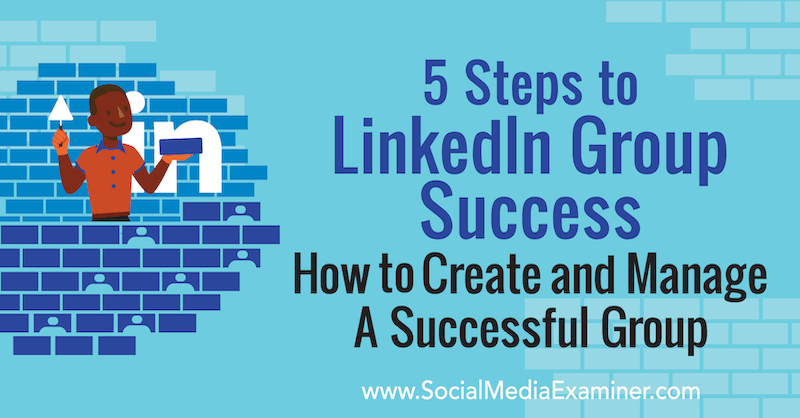
Why You Should Manage Your Own LinkedIn Group
Starting your own LinkedIn group can be a great way to increase your thought leadership and attract a highly targeted group of people if you leverage it the right way. Here are some of the benefits of creating your own LinkedIn group:
- Significantly increase the size of your LinkedIn network, making it easier to find or be found by your target market.
- Message up to 15 group members each month to whom you're not directly connected (the 15 messages are split among all of your groups).
- Show up in more places. Groups are accessible and discoverable from the LinkedIn home page and relevant group conversations will appear in the main feed, keeping you top of mind with your target market.
- Create an ideal environment for interacting with prospects and clients.
- Position yourself as an authority on your topic or in your niche.
The most successful LinkedIn groups have a relentless commitment to maintaining quality and consistently providing value to group members. Here's how to get started with your own group.
#1: Create a New LinkedIn Group
Creating a LinkedIn group is easy. To begin, click Work at the right of the top navigation bar and select Groups from the pop-up menu.
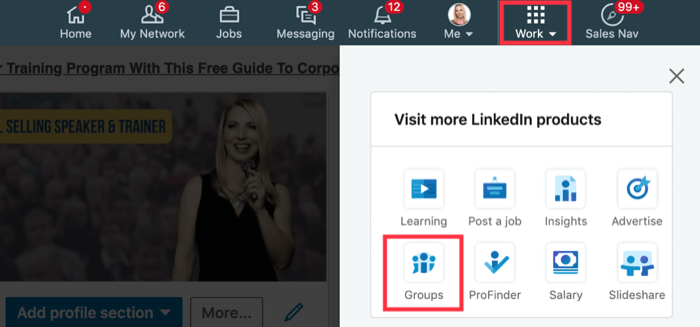
This opens a list of the LinkedIn groups you belong to. Click Create a New Group in the top-right corner of the page.

Now fill in the following details about your group.
Strategically Name Your LinkedIn Group
The name you choose for your LinkedIn group should target the specific people you want to attract. The more focused your niche is, the more attractive your group should be to those people when they find it.
If you want to attract people from a specific geographic area, include the name of the city or area. To illustrate, if your target market is businesspeople in London, you may want to name your group “London Business Networking Group.” These are some of the keywords people will search for when looking for LinkedIn groups to join.
When I was naming my group, I wanted to attract people interested in social selling. Because they could be located anywhere, I called the group Social Selling Globally.
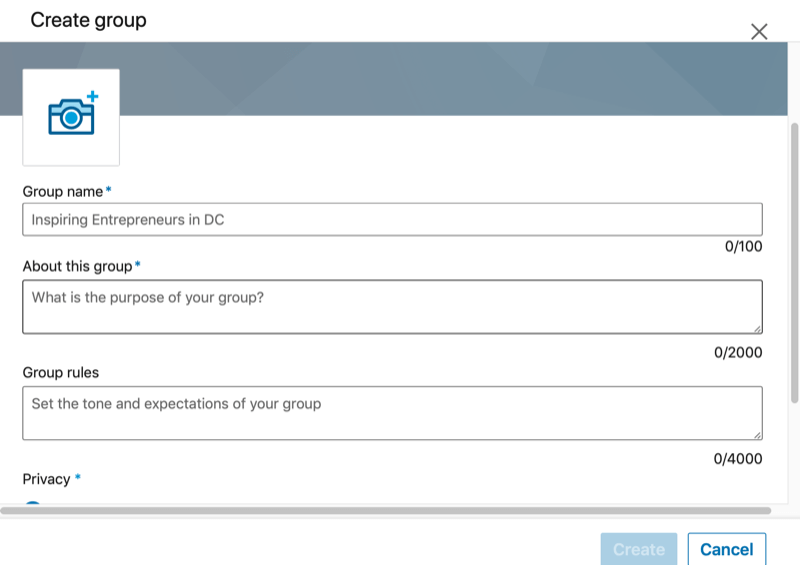
It's important to note a group name can't exceed 100 characters and can only be used by one group at a time so you'll need to choose a unique group name.
Get World-Class Marketing Training — All Year Long!
Are you facing doubt, uncertainty, or overwhelm? The Social Media Marketing Society can help.
Each month, you’ll receive training from trusted marketing experts, covering everything from AI to organic social marketing. When you join, you’ll also get immediate access to:
- A library of 100+ marketing trainings
- A community of like-minded marketers
- Monthly online community meetups
- Relevant news and trends updates
One common mistake businesses make when starting a LinkedIn group is to name the group after the business and use it to broadcast company updates.
Don't make this mistake.
People who join LinkedIn groups don't want to be bombarded by your updates. Reserve your updates for your LinkedIn company page or the occasional status update on your personal LinkedIn profile.
People join LinkedIn groups to be a part of a community of like-minded people where they can have conversations about things that are important to them and the community as a whole.
LinkedIn defines groups in the following way:
“LinkedIn Groups provide a place for professionals in the same industry or with similar interests to share their insights and experiences, ask for guidance, and build valuable connections.”
If you build a LinkedIn group with these goals in mind, you'll be much more successful.
Assign Visual Branding Elements to Your LinkedIn Group
Creating a custom logo and cover image for your LinkedIn group ensures it looks professional. A professionally branded group adds credibility, enticing new members.
The logo for a LinkedIn group is square and should be at least 60 x 60 pixels. The recommended size for the cover image is 1776 x 444 pixels. The images should be in JPEG or PNG format.
If you want to add (or edit) a logo or cover image for an existing group, click on the three dots located just under the cover photo on the right side. From the drop-down menu, select Edit Group Information.
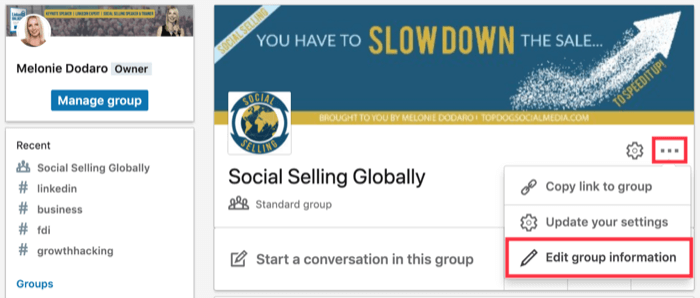
Click on the pencil in the cover photo or logo area to add the image. When you're done, click Save at the bottom of the window.
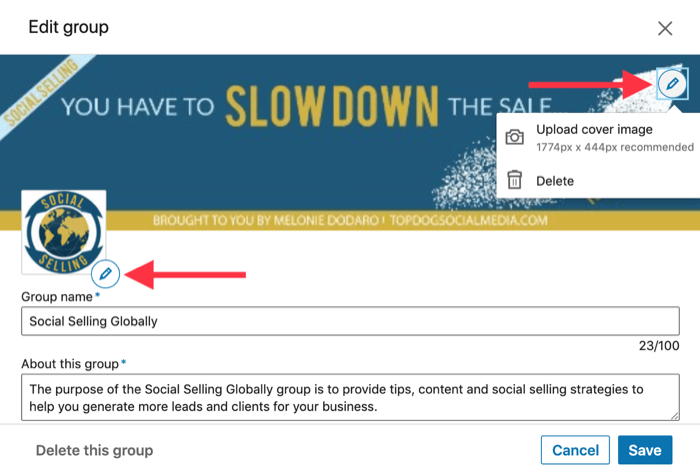
Optimize the ‘About This Group' Section for Search Visibility
The About This Group section is where you can define the culture and purpose of your group. Be sure to take advantage of the 2,000-character limit.
Remember that you're trying to entice potential members so speak to your ideal target audience using the language they'll use when searching. Expand on why you created the group and who will benefit from joining.
Also give people a good idea of the content they can expect from the group.
Keep in mind that when people search for groups on LinkedIn, only the first approximately 200 characters of the About section will be visible beside your group name in the search results.
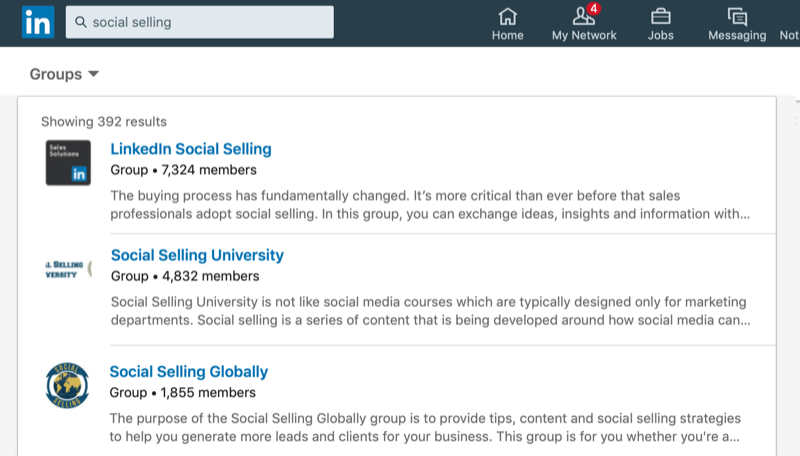
Because you have only a sentence or two to capture a potential member's attention and entice them to join your group, focus on these key details when writing this first part of the About This Group section:
- If you want to attract a specific industry or profession, mention it here.
- Write a brief sentence about what users can expect and what value they can gain by joining your LinkedIn group.
- Use specific keywords that will grab your target audience's attention.
Define the Rules for Your LinkedIn Group
It's important to outline clear rules and guidelines when setting up your LinkedIn group. This helps you maintain the integrity of your group and keep spammers out. Ensure all posts and conversations provide value and engage group members.
I recommend having a simple but strict policy on promotional content. You have a 4,000-character limit for rules, but you don't want to make reading your rules long and boring.
For my own group, I clearly set group expectations in just over 700 characters.
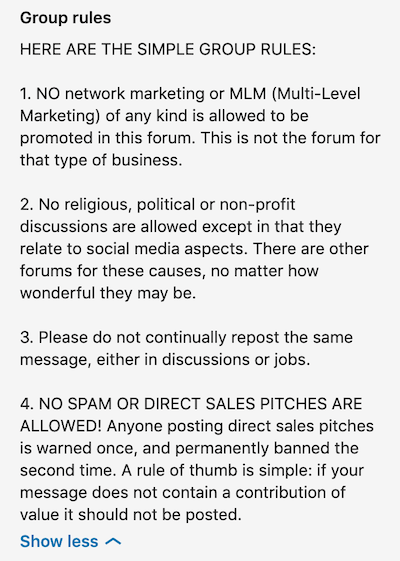
For clarity, you can include information on how repeated violations will be handled.
Pro Tip: I can't stress enough how important it is to set and police your group rules. If you allow people to spam the group, members will stop visiting and engaging because they'll struggle to find posts of value. Many may even leave your group.
This being said, all group members should be encouraged to post if they offer clear value and relevance to the group's members and purpose.
Make Your LinkedIn Group Searchable or Unlisted
LinkedIn groups have two privacy settings:
- Standard groups are visible in search results. Members can also invite other members to join.
- Unlisted groups don't appear in LinkedIn's search results and only group admins can invite members to join.
You'll generally want to select a standard group.


Discover Proven Marketing Strategies and Tips
Want to go even deeper with your marketing? Check out the Social Media Marketing Podcast! Publishing weekly since 2012, the Social Media Marketing Podcast helps you navigate the constantly changing marketing jungle, with expert interviews from marketing pros.
But don’t let the name fool you. This show is about a lot more than just social media marketing. With over 600 episodes and millions of downloads each year, this show has been a trusted source for marketers for well over a decade.
The only instance when you'd want an unlisted group is if you require the information about and access to the group to be restricted to very select people. A members-only unlisted group is great for an internal company group for employees, organization members, a private client group, or anything specific to a small number of people.
#2: Seed Your LinkedIn Group With Content
Before you begin promoting your group or inviting members to join, post content to your group. This content should be carefully selected, whether curated or created, and of interest and value to your members.
Start by creating three or four posts. Here are some ideas for posts:
- Solve a key challenge for your target market.
- Discuss new trends or current issues your industry is facing.
- Choose topics that you would like to create some discussion around using a question or your opinion.
To ensure new and existing members always find fresh content of value to them, plan to share at least one new content post a week.
#3: Invite People to Join Your LinkedIn Group
Once you've posted some engaging content, you're ready to actively invite people to join your group. How LinkedIn members can join will depend on which type of group you selected.
If you chose an unlisted group, only those people that you or your fellow group admins invite can join the group. This allows you to fully control who's in your group and how big it gets.
If you have a standard group, people can join three ways:
- You invite your connections based on how well they meet your membership criteria.
- Other group members invite them.
- LinkedIn members find and request to join your group when searching for groups to join.
Any member of a standard LinkedIn group can invite their connections to join your group. They can do this by clicking Invite Members to the right of the group name below the number of members. Note they also can approve requests to join the group.
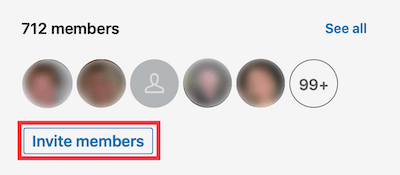
There are definite pros and cons to allowing members to send invites and approve requests.
While it can help you build your group more quickly, unfortunately it can also lower the quality of the group. This means you'll want to ensure you regularly moderate your group by:
- Accepting or denying requests to join your group
- Removing spam
- Blocking or deleting members who have broken the rules
To help mitigate this issue before it becomes an unmanageable problem, determine your membership criteria before you begin inviting new members. Also carefully review member profiles prior to approval. Start with a smaller group of engaged members and then grow your group size.
There's plenty of room for growth with a default maximum group size of 20,000 members. If you get close to 19,500 members—anticipating you'll exceed this limit while complying with LinkedIn policies—you can contact LinkedIn to request to increase your member limit.
#4: Promote Your LinkedIn Group
Here are some great ways to promote your group:
- Encourage group members to invite connections who would benefit from and contribute value to the group.
- Post the link to your group with a summary of your About This Group section to clarify who would benefit from joining the group.
- Display the group on your profile and encourage other members to do the same.
- Include the group link in your email signature.
- Share the group link with a brief summary in your newsletter.
As new members join your group, welcome them by @mentioning their name, especially when your group is small and just beginning to grow.
Pro Tip: If you want to create high levels of engagement in your group, you can even ask new members to introduce themselves and tell the group what they hope to gain from the community. This tactic can help quickly build a sense of community among the members.
#5: Manage Your LinkedIn Group
As an admin, you'll need to perform a number of management tasks for your group. Some of these tasks will need to be done regularly, while others can be done as needed.
Two management tasks you need to perform regularly (ideally multiple times a week) are reviewing new content or engagement for spam and accepting (or denying) new requests to join the group.
Each time you visit your group, scroll through the feed looking for and removing any content or engagement that isn't of value to the group. This type of content may not always look like spam. Anything that isn't on topic for the group or that the group won't find of interest or value is spam.
You can also post your own content at this time and engage as appropriate with other posts and comments.
To remove a post, recommend a post to the group, or block the group member who posted it, click the three dots in the top-right corner of the post and select the appropriate action.
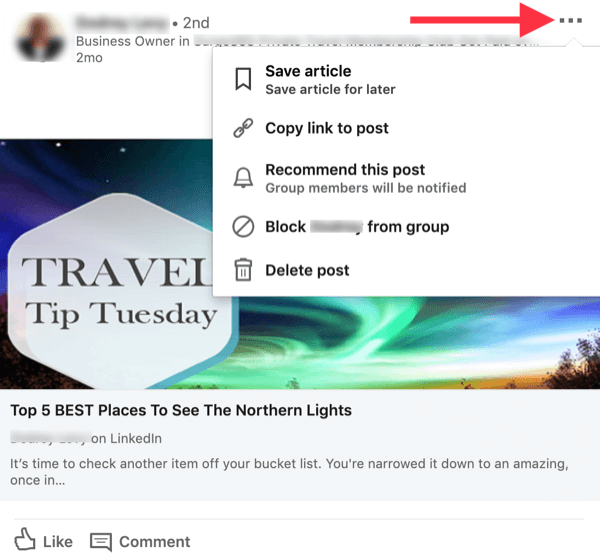
You can easily manage requests to join your group by clicking the blue Manage Group button located below your name in the top-left corner of the group page.
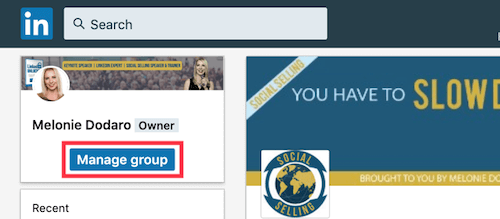
After the member list opens, click on Requested in the navigation box on the left side of the page.
Visit the profiles of people requesting to join your group to ensure they meet your membership criteria.
If they don't have a profile image or headline or you can't see their full name, you can usually deny these requests without further investigation. If they haven't taken the time to update their LinkedIn profile, they aren't likely to contribute in a meaningful way to your group.
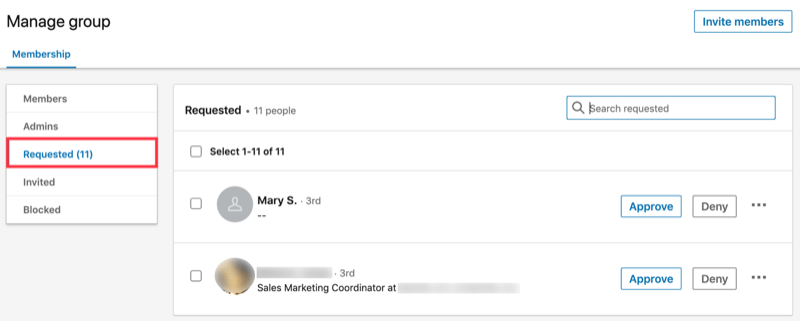
Once or twice a month, you may want to go into the Invited section in the management area and rescind old invitation requests. If someone hasn't accepted the invite within a month, they aren't likely to in the future.
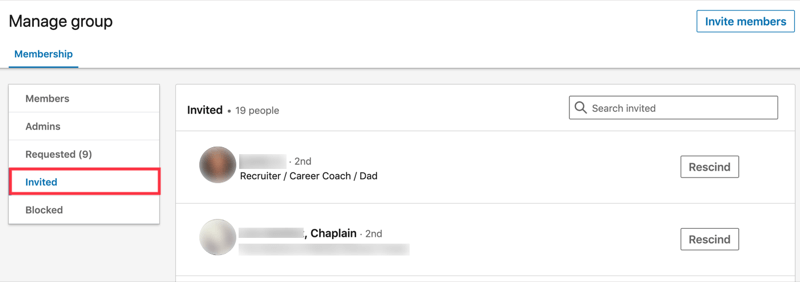
From time to time, you may want to add a manager to your page to help you manage your group. LinkedIn makes this quick to do (or undo).
Go to the Members list and search for the person's name (they must be a member of your group). When you find them, click the three dots next to the message button in their profile box.
From the drop-down menu, select Make Manager and click Confirm in the confirmation box.
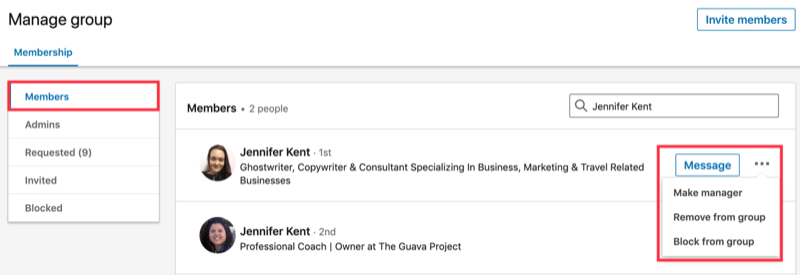
If you navigate to the Admins page, you can easily remove someone as a manager of your page. Click the three dots and select Remove Manager Permissions. Then click Confirm in the confirmation box.
If you want to pass on ownership of the group, click the three dots beside the person to whom you want to transfer it and select Transfer Ownership. Then click Confirm in the confirmation box.
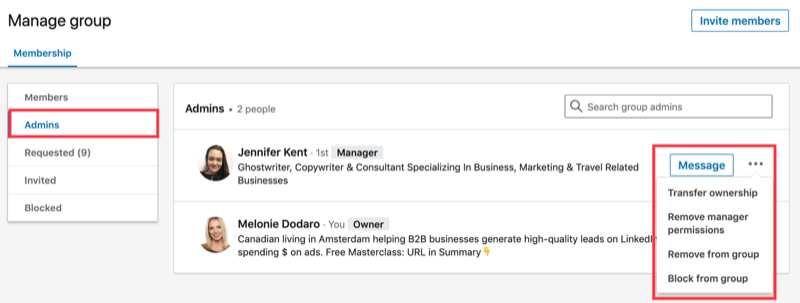
You may also wish to unblock someone from the group. To do this, navigate to Blocked. Then locate the person you wish to unblock and click Unblock From Group beside their name.

Conclusion
Creating a LinkedIn group that your target market would want to join takes some time and commitment. But if you're clear on whom your group is meant to serve and you work to provide regular benefit to your members, you can build a valuable, engaged community.
What do you think? Will you consider building a LinkedIn group for your business? If you already have a LinkedIn group, do you have any tips to offer for growing a group? Share your thoughts in the comments below.
More articles on LinkedIn marketing:
- Learn how to create LinkedIn articles that amplify your reach and engagement on LinkedIn.
- Discover how to use four LinkedIn marketing features to nurture leads.
- Find a step-by-step process to help you create a LinkedIn content marketing plan.
Attention Agency Owners, Brand Marketers, and Consultants

Introducing the Marketing Agency Show–our newest podcast designed to explore the struggles of agency marketers.
Join show host and agency owner, Brooke Sellas, as she interviews agency marketers and digs deep into their biggest challenges. Explore topics like navigating rough economic times, leveraging AI, service diversification, client acquisition, and much more.
Just pull up your favorite podcast app, search for Marketing Agency Show and start listening. Or click the button below for more information.

